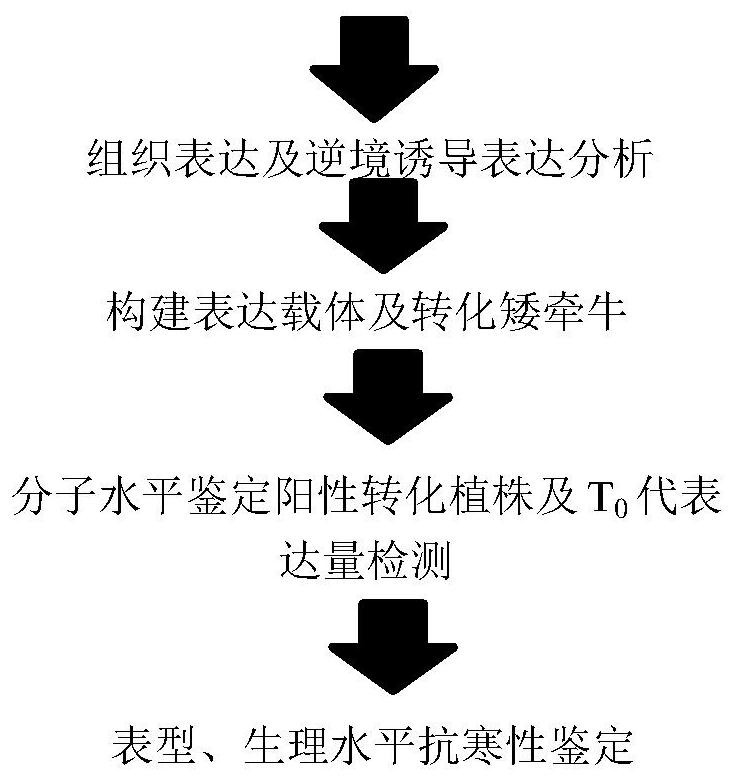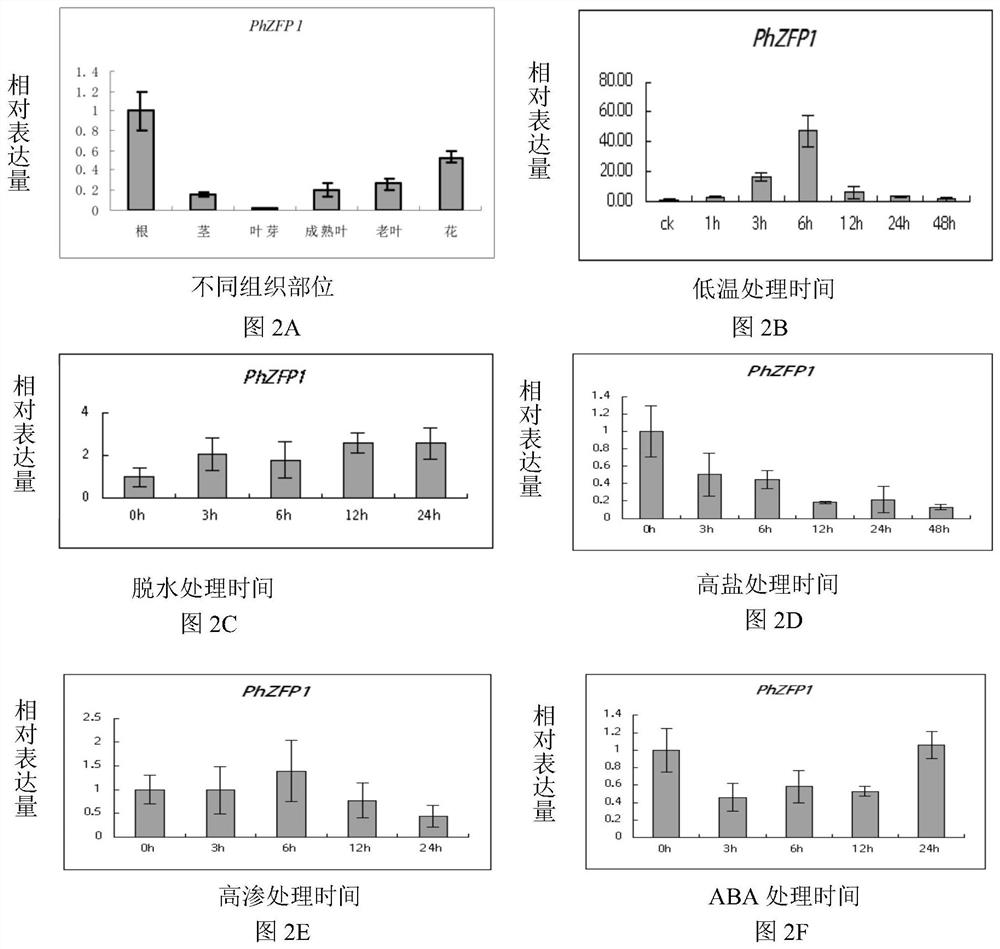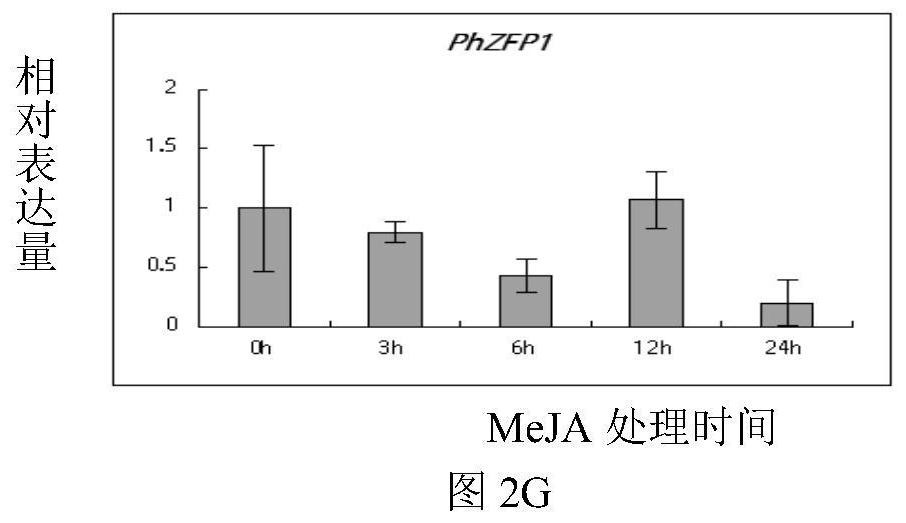Petunia zinc finger protein gene phzfp1 and its application in improving plant cold resistance
A petunia and cold resistance technology, applied in the field of plant genetic engineering, can solve problems such as the reduction of ZAT10/STZ expression, and achieve the effect of stable resistance
- Summary
- Abstract
- Description
- Claims
- Application Information
AI Technical Summary
Problems solved by technology
Method used
Image
Examples
Embodiment 1
[0031] Example 1 Isolation and cloning of PhZFP1 gene
[0032] The research group evaluated the cold resistance of the preserved petunia inbred lines in the early stage, and screened out the more cold-resistant line "H" (Li B, Ning L, Zhang J, Bao M, Zhang W. Transcriptional profiling of Petuniaseedlings reveals candidate regulators of the cold stress response. Frontiersin Plant Science. 2015;6:118.), and preliminarily screened the candidate gene PhZFP1 in the cold response pathway by using the expression profile chip of "H" under low temperature stress. Using an EST sequence obtained from the expression profile chip data as an informative probe, it was compared with the genome sequence and transcriptome sequence in the petunia database, and the CDS sequence of the zinc finger protein gene PhZFP1 was obtained by analysis. Contain introns, use PrimerPremier 5 software to design a pair of outer primers containing part of the UTR region, the primers were synthesized by Shanghai S...
Embodiment 2
[0049] Example 2 Analysis of PhZFP1 tissue expression profile and induced expression profile
[0050] According to the gene sequence obtained in the petunia database and the requirements of real-time quantitative PCR primers, a pair of specific primers was designed with PrimerPremier 5 software, forward primer: 5'-CCTCCACCTCTGCCACCACTT-3', reverse primer: 5'-CACCGTTGCCGCCATCATAA-3 '. The tissue expression profile and induced expression profile of the candidate gene PhZFP1 were analyzed by RT-PCR.
[0051] The extraction of total RNA and the reverse transcription reaction of total RNA were performed using the EASYspin Plant RNA Rapid Extraction Kit produced by Adelaide and the PrimeScript produced by TaKaRa. TM RTReagent Kit with gDNA Eraser Reverse Transcription Kit, the specific steps are carried out according to the instructions. The real-time quantitative PCR reaction was carried out in the ABI 7500fast fluorescence detection system, and the operation steps were in accor...
Embodiment 3
[0054] Example 3 Construction of PhZFP1 overexpression vector
[0055] After connecting PhZFP1 to pMD 18-T vector, the correct plasmid was sequenced, digested with Sal1 and BamH1, and connected to the plant expression vector pCambia2300s (preserved by our laboratory, see image 3 A). The 35S primer (5'-ACGCACAATCCCACTATCCTTC-3') was paired with the outer downstream primer of the target gene: 5'-GCCTTTATCTTCATCAAGCCCTACA-3' for colony PCR detection, and the positive bacteria were picked to extract the plasmid. p2300-PhZFP1 vector (see image 3 B), and the bacterial liquid was mixed with 50% glycerol in a volume ratio of 7:3, and stored at -80°C for later use. The recombinant plasmid was then electroporated into Agrobacterium strain EHA105 (kept by our laboratory).
PUM
 Login to View More
Login to View More Abstract
Description
Claims
Application Information
 Login to View More
Login to View More - R&D
- Intellectual Property
- Life Sciences
- Materials
- Tech Scout
- Unparalleled Data Quality
- Higher Quality Content
- 60% Fewer Hallucinations
Browse by: Latest US Patents, China's latest patents, Technical Efficacy Thesaurus, Application Domain, Technology Topic, Popular Technical Reports.
© 2025 PatSnap. All rights reserved.Legal|Privacy policy|Modern Slavery Act Transparency Statement|Sitemap|About US| Contact US: help@patsnap.com



